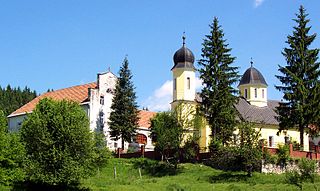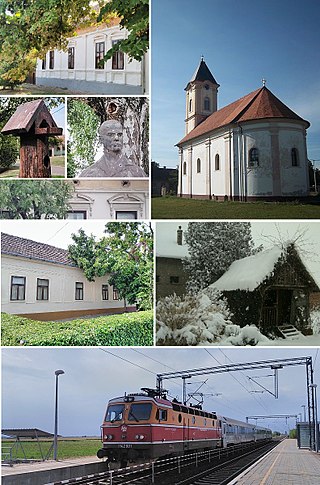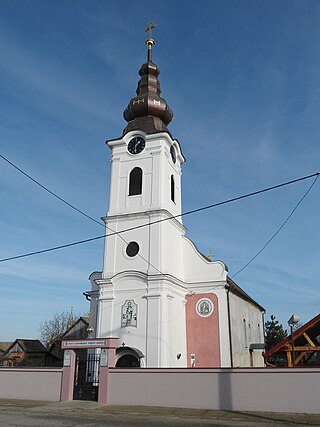
The Eparchy of Srem is an eparchy (diocese) of the Serbian Orthodox Church in the Syrmia (Srem) region, Serbia. Most of the eparchy is in the autonomous province of Vojvodina, and it also includes a small south-eastern part of Syrmia within the city limits of Belgrade, as well as some West Syrmian parishes in the border region of Croatia. The seat of the eparchy is at Sremski Karlovci. Since 1986, the diocesan bishop is Vasilije Vadić.

Tovarnik is a municipality in the Vukovar-Syrmia County in Croatia next to the border with Serbia with the town of Šid and the village of Ilinci on the other side of the border. According to the 2001 census, there are 2,775 inhabitants, 91.06% which are Croats. The municipality is part of Syrmia. It is the birthplace of great Croatian poet Antun Gustav Matoš. Tovarnik is underdeveloped municipality which is statistically classified as the First Category Area of Special State Concern by the Government of Croatia.

Eastern Orthodoxy in Croatia refers to adherents, religious communities, institutions and organizations of Eastern Orthodox Christianity in Croatia. It is the second-largest religious denomination in Croatia, behind the Roman Catholic Church. Over 128 000 people, forming 3.32% of the total Croatian population, are Eastern Orthodox Christians (2021).

Banovci ;, also known as Šidski Banovci, is a village located in the Vukovar-Syrmia County of Croatia, near the Serbian border. The village had a population of 256 as of the 2021 census.

The Eparchy of Osječko Polje and Baranja is a eparchy (diocese) of the Serbian Orthodox Church that encompasses the easternmost regions of Croatia in Podunavlje region, with its seat located in the village of Dalj. The eparchy was re-established in 1991, covering the western parts of what was previously the Eparchy of Srem. The cathedral of the Eparchy is the Church of St. Demetrius in Dalj. The Eparchy is divided into three vicarages, located in Osijek, Vukovar and the region of Baranja, and is served by a total of 39 priests and two deacons.

The Order of Kantakuzina Katarina Branković is an ecclesiastical honor bestowed by the Metropolitanate of Zagreb and Ljubljana, an eparchy (diocese) within the Serbian Orthodox Church. This order is conferred upon individuals in recognition of their contributions to the Serbian Orthodox Church in the regions encompassing Croatia, Slovenia, and Italy.

The Church of the Holy Venerable Mother Parascheva is a Serbian Orthodox church located in Banovci, Vukovar-Syrmia County, in eastern Croatia. Constructed in 1819, this neoclassical church is dedicated to Paraskeva of the Balkans.

The Church of St. George in Bobota is Serbian Orthodox church in eastern Croatia. The church is famous for its icons in the iconostasis that were painted in 1778. During the Croatian War of Independence, administration of Eparchy of Osječko polje and Baranja sent the icons on the restoration and preservation in Vojvodina. The icons were returned to the church after the end of war. The decision to remove the cultural property from the church caused controversy and was an open issue in Croatia–Serbia relations up until the final return of icons.

The Church of St. Stephen in Borovo is a Serbian Orthodox church in eastern Croatia. The church was built in the period from 1761 to 1764. First educational activities in the village were carried out under its patronage. Church is listed in Register of Cultural Goods of Croatia. Iconostasis with 49 icons and other inventory is also specifically listed in Register.

Archbishopric of Belgrade and Karlovci is the central or patriarchal eparchy of the Serbian Orthodox Church, with seat in Belgrade, Serbia. The head of the eparchy is the Serbian patriarch.

Church of St. Nicholas in Jagodnjak is Serbian Orthodox church in eastern Croatia. The church was built in 1725. Church gain attention in 2012 when local believer claimed apparation of Nectarios of Aegina in her dream. In 2013 special place in church with saint's icon was built, and pilgrimage to Aegina was organized. In 2015 Eparchy of Osječko polje and Baranja initiated building of smaller church dedicated to Nectarios of Aegina.

The Church of St. Demetrius is a Serbian Orthodox cathedral in Dalj, eastern Croatia, serving as the seat of the Eparchy of Osječko polje and Baranja. Originally established in 1715, the current church was completed in 1799, combining of Baroque and Classicist architectural styles. It is the largest Serbian Orthodox cathedral in Croatia and an protected cultural and historical monument. Over the years, the church has been a central place of worship for the Serbian Orthodox community in the Podunavlje region, enduring multiple restorations and reconstructions, particularly after damage sustained during both World Wars. The church's iconostasis, crafted in 1824, adds to its cultural prominence. The building is located next to the Patriarchal Court, historically used as a summer residence for Serbian patriarchs.

The Church of St. George in Kneževo is Serbian Orthodox church in eastern Croatia. Church was built by the decision of the King of Yugoslavia Alexander I of Yugoslavia in 1929 as a part of the royal summer residence. There are two thrones, one for king and another one for queen, made of walnut wood which are part of interior of the church building.

Church of Saint Parascheva is a Serbian Orthodox church located in Slabinja, Sisak-Moslavina County, in central Croatia. It was dedicated to Saint Parascheva of the Balkans. The Church was built in 1828 and demolished during World War II. Only the perimeter walls are preserved.

The Church of the Presentation of Mary in Popovac is a Serbian Orthodox church in eastern Croatia. The exact date of the construction of the church is unknown with dates ranging from 1726, local judge report noting that the foundations were built in 1767 and Baranya County statistical report in 1757 mention the church in the village. The building was reconstructed between 1905 and 1912. Today, it is one of the three Serbian Orthodox churches in the municipality.

The Church of St. George in Opatovac is Serbian Orthodox church in eastern Croatia. Church was built in 1802 with the iconostasis is from 1769. The church is located in the centre of the village next to the main D2 road between Vukovar and Bačka Palanka.

The Church of the Transfiguration of the Lord in Šarengrad is a Serbian Orthodox church in eastern Croatia. The church was built between 1791 and 1800. The church is located in the centre of the village next to the main D2 road between Vukovar and Bačka Palanka and near the Danube river. Before the construction of the contemporary building there was an older and smaller Serbian Orthodox church in the village which was built in 1704. The first historical records on the intention to build the new church come from 1781 when at the time Vukovar Estates plenipotentiary Michael Cseh wrote to Count Hugo Philippus Eltz on the issue of production of materials for the new building.

The Church of the Transfiguration of the Lord in Mohovo is a Serbian Orthodox church in eastern Croatia. The church was constructed in between 1836 and 1839 with the iconostasis from 1857 built by Bogdan Đukić from Tovarnik, the same artist who built the iconostasis in Serbian Orthodox church in Petrovci. After the first general restoration in 1936 the new general restoration of the building was initiated in 2017.

Church of the Saint Archangel Michael in Ilok is a Serbian Orthodox church in eastern Croatia. Contemporary church was built in 2016 as an exact copy of the previous church which was built at the same location between 1798 and 1802 and which was destroyed in 1942 during the Genocide of Serbs in the Independent State of Croatia during the World War II in Yugoslavia. An older Serbian Orthodox church was constructed further away from the centre of the town in 1702 but at the time of construction of the new church that building was already ruined.




























